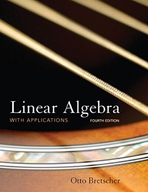In Exercises 53 and 54, we will work with the binary digits (or bits) 0 and 1, instead
Chapter 3, Problem 53(choose chapter or problem)
In Exercises 53 and 54, we will work with the binary digits (or bits) 0 and 1, instead of the Teal numbers R. Addition and multiplication in this system are defined as usual, except for the rule 1 -1- 1 = 0. We denote this number system with F2, or simply F. The set of all vectors with n components in F is denoted by Fn; note that F consists of 2n vectors. (Why?) In information technology, a vector in F8 is called a byte. (A byte is a string of 8 binary digits.)The basic ideas of linear algebra introduced so far (for the real numbers) apply to F without modifications. A Hamming matrix with n rows is a matrix that contains all nonzero vectors in F" as its columns (in any order). Note that there are 2n 1 columns. Here is an example:3 rows 23 1 = 7 columns.a. Express the kernel of H as the span of four vectors in F7 of the form1 0 0 1 0 1 1 H = 0 1 0 1 1 0 1 0 0 1 1 1 1 0v \ =* * * ** * * ** * * *b. Form the 7 x 4 matrix II CM0 < V3 = 0 , v4 = 0 0 1 0 0 0 0 1 0 0 0 0 1M = V\ V2 V3 I V4 Explain why \m(M) = ker(//). If x is an arbitrary vector in F4, what is H(Mx)l
Unfortunately, we don't have that question answered yet. But you can get it answered in just 5 hours by Logging in or Becoming a subscriber.
Becoming a subscriber
Or look for another answer
